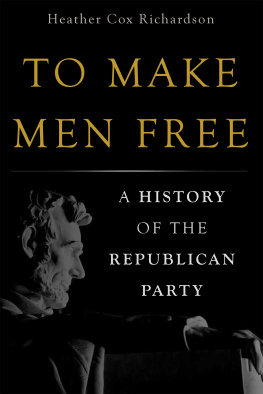The
Southern Strategy
Revisited
The
Southern Strategy
Revisited

Republican
Top-Down Advancement
in the South
Joseph A. Aistrup

Copyright 1996 by The University Press of Kentucky
Scholarly publisher for the Commonwealth,
serving Bellarmine University, Berea College, Centre
College of Kentucky, Eastern Kentucky University,
The Filson Historical Society, Georgetown College,
Kentucky Historical Society, Kentucky State University,
Morehead State University, Murray State University,
Northern Kentucky University, Transylvania University,
University of Kentucky, University of Louisville,
and Western Kentucky University.
All rights reserved.
Editorial and Sales Offices: The University Press of Kentucky
663 South Limestone Street, Lexington, Kentucky 40508-4008
www.kentuckypress.com
Cataloging-in-Publication Data is available from the Library of Congress.
ISBN 978-0-8131-1904-5 (cloth: alk. paper)
This book is printed on acid-free recycled paper meeting the requirements of the American National Standard for Permanence in Paper for Printed Library Materials.

Manufactured in the United States of America.

| Member of the Association of
American University Presses |
For Shelley, Sarah, and Samuel
CONTENTS
FIGURES, TABLES, AND MAPS
FIGURES
TABLES
MAPS
ACKNOWLEDGMENTS
IN THE 1986 ELECTIONS, PRESIDENT RONALD REAGAN, ONE OF THE MOST popular presidents in modern history, expended much political capital to help the Republicans maintain control of the U.S. Senate. Despite his extensive campaigning in the South, the Republicans lost control of the four seats that they had won in 1980 and, consequently, control of the U.S. Senate. Ironically, in the same election the Republicans won governorships in many of the same states that they lost U.S. Senate seats. This event, more than any other, initiated my interests in Southern politics.
As I began to read about Southern politics, I was impressed with the breadth and quality of the work. Scholars such as V.O. Key, Charles Bullock, Alexander Lamis, Jack Bass, Walter De Vries, Earl Black, and Merle Black have studied the South extensively. Their works enlightened me concerning the various nuances of Southern politics, and I am indebted to each of these scholars.
Like most students of Southern politics, I became interested in the emerging Republicanism in the South. However, the focus of most Southern politics research was on the statewide or national level, or on partisanship. Although these analyses have resolved many significant questions, there were still many significant propositions that this literature was unable to convincingly answer.
As I began my research, I turned my attention to the forgotten level of analysisthe local levelwhere there was much fertile soil. I became intrigued with the question of why the Republicans were making such great progress at the statewide/national level, while at the same time making little headway at the local level. This book is an attempt to answer this question.
There are many people to thank. Professor Ronald Weber and Professor James Gibson provided important data that allowed me to complete . Each of the Republican state parties gave valuable information concerning their local organizations. In addition, several current and former Republican state party chairs were kind enough to grant interviews.
The Indiana University Political Science Department provided an intellectually stimulating environment and financial support throughout my graduate career that enabled me to complete this project as a dissertation. The Virginia Tech Political Science Departments secretarial staff did an excellent job of typing the numerous versions of the manuscript. I will be forever indebted to Kim, Terry, and Maxine. The Docking Institute of Public Affairs at Fort Hays State University and its director, Mark Bannister, gave me the additional time to finish the final draft of the manuscript. David Warren did a superb job of both editing and commenting on numerous drafts of the manuscript. I am especially thankful to Professor Gerald Wright, whose guidance as my dissertation chair enabled me to get the project off the ground. Jerry suffered through numerous drafts of my proposal and chapters, pointed me in the correct direction whenever I went astray, and provided me with both moral and financial support. He is a valuable mentor.
Finally, my wife, Shelley, tolerated many earlier mornings and shouldered much of my parental responsibilities so that I could finish this project in all of its numerous forms. It will take a lifetime for me to repay her.
INTRODUCTION
TAKING ADVANTAGE OF PRESIDENT CLINTONS LACK OF POPULARITY IN the South, the 1994 mid-term elections represented a watershed election for the Republicans in the South and in the rest of the nation. Republicans won five of six U.S. Senate contests in the South, including both senate seats in Vice President Al Gores home state of Tennessee. The Democrats only senate win was in Virginia, where incumbent Democrat Charles Robb beat Oliver North of Iran-Contra fame. Adding insult to injury, Senator Richard Shelby (Ala.) defected from the Democrats, joining the Republicans the day after the election.
At the gubernatorial level the Republicans won four of seven contested seats. The news for Southern Democrats easily could have been worse. Democratic gubernatorial incumbents Lawton Chiles in Florida and Zell Miller in Georgia won by the narrowest of margins. Perhaps most disturbing for the Southern Democrats were the losses at the U.S. House level, where the Republicans picked up one seat in Mississippi, Virginia, and South Carolina; two seats in Florida, Texas, and Tennessee; three seats in Georgia; and four seats in North Carolina. Based largely on the strength of the GOPs performance in the South, the Republicans took control of both houses of Congress.
In the wake the 1994 elections in the South, Republicans control 13 of 22 U.S. Senate seats, 6 of 11 governorships, and 64 of 125 U.S. House seats. This marks the first time in this century that the GOP controls a majority at these three levels, easily surpassing their 1980 showing when they gained control of ten U.S. Senate seats, five governorships, and slightly over 30 percent of U.S. House seats (Bullock 1987). As commentators have noted, Democratic president Bill Clinton did more for Southern Republicans in two years than the combined effects of twelve years of Republican presidents Ronald Reagan and George Bush.
Southern Republicans also made gains at the state legislative level. The most impressive Republican increases occurred in North Carolina, where the GOP gained twenty-six state house seats to take control (68R/52D) of that chamber. In addition, North Carolina Republicans added thirteen upper chamber seats. (North Carolina State Senate Democrats still maintain a two seat majority.) South Carolina Republicans now have a plurality in the lower house (62R/58D) after gaining ten seats. Georgia Republicans also did well, picking up five state senate seats and thirteen state house seats. Georgia Democrats, however, still maintain large majorities in both chambers (fifteen seats in the senate and forty-nine seats in the house). Alabama Republicans gained four seats in the upper chamber and eight seats in the lower chamber. Florida Republicans added eight seats in the lower house and one seat in the senate, enabling the Florida GOP to take control of the Florida State Senate. While the GOP gains in these states were significant, the Republican state legislative gains in Arkansas, Texas, and Tennessee were less impressivethey totaled less than five seats for both chambers combined in each state, despite the Republican U.S. Senate landslides in Texas and Tennessee.












